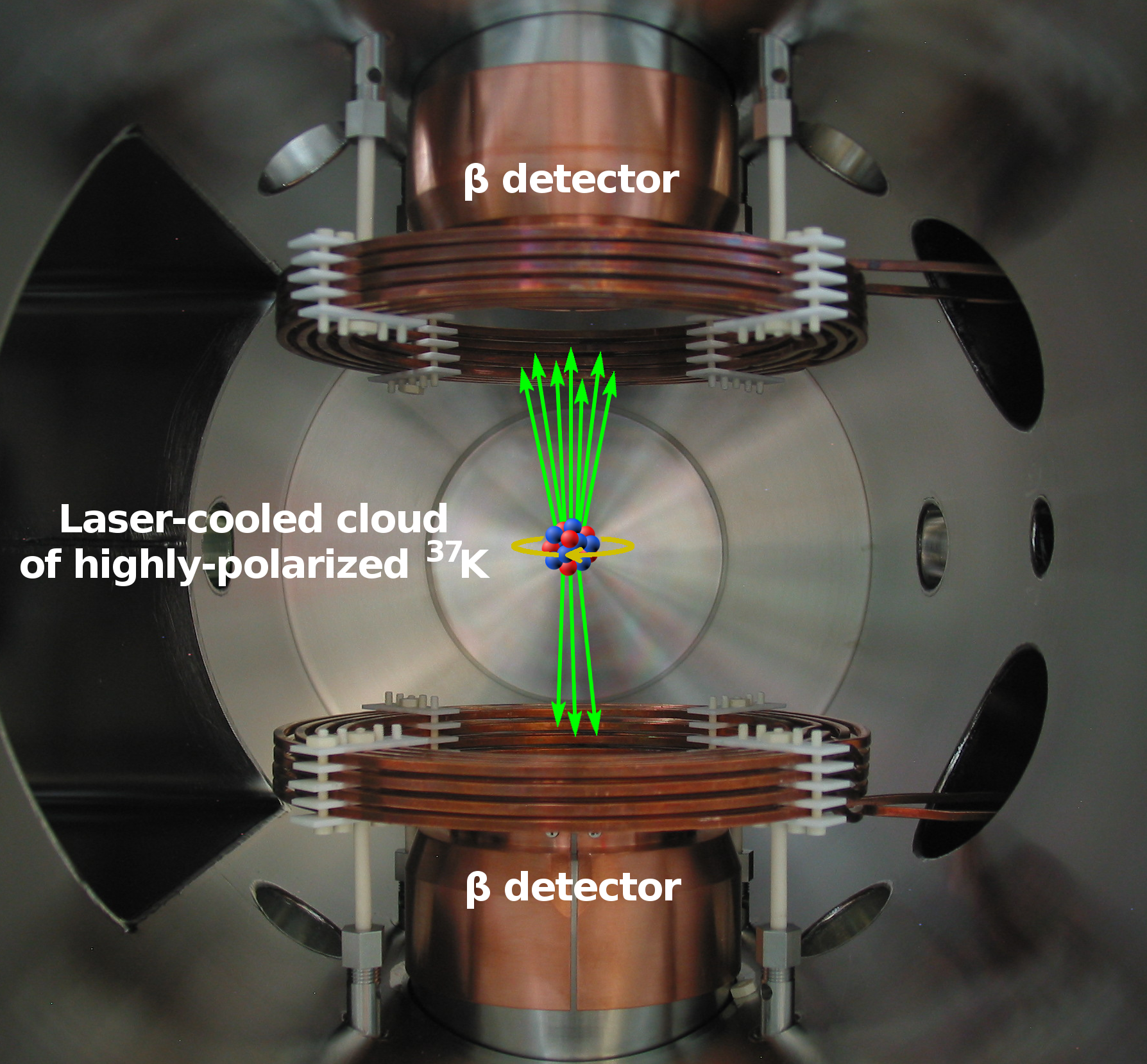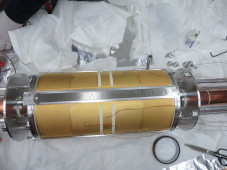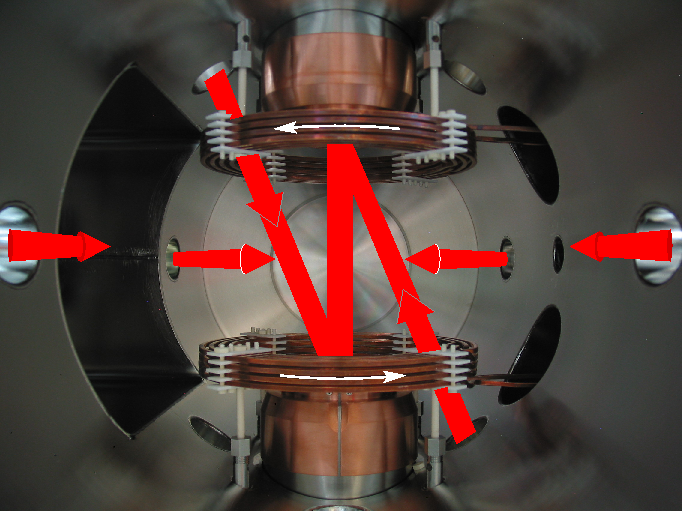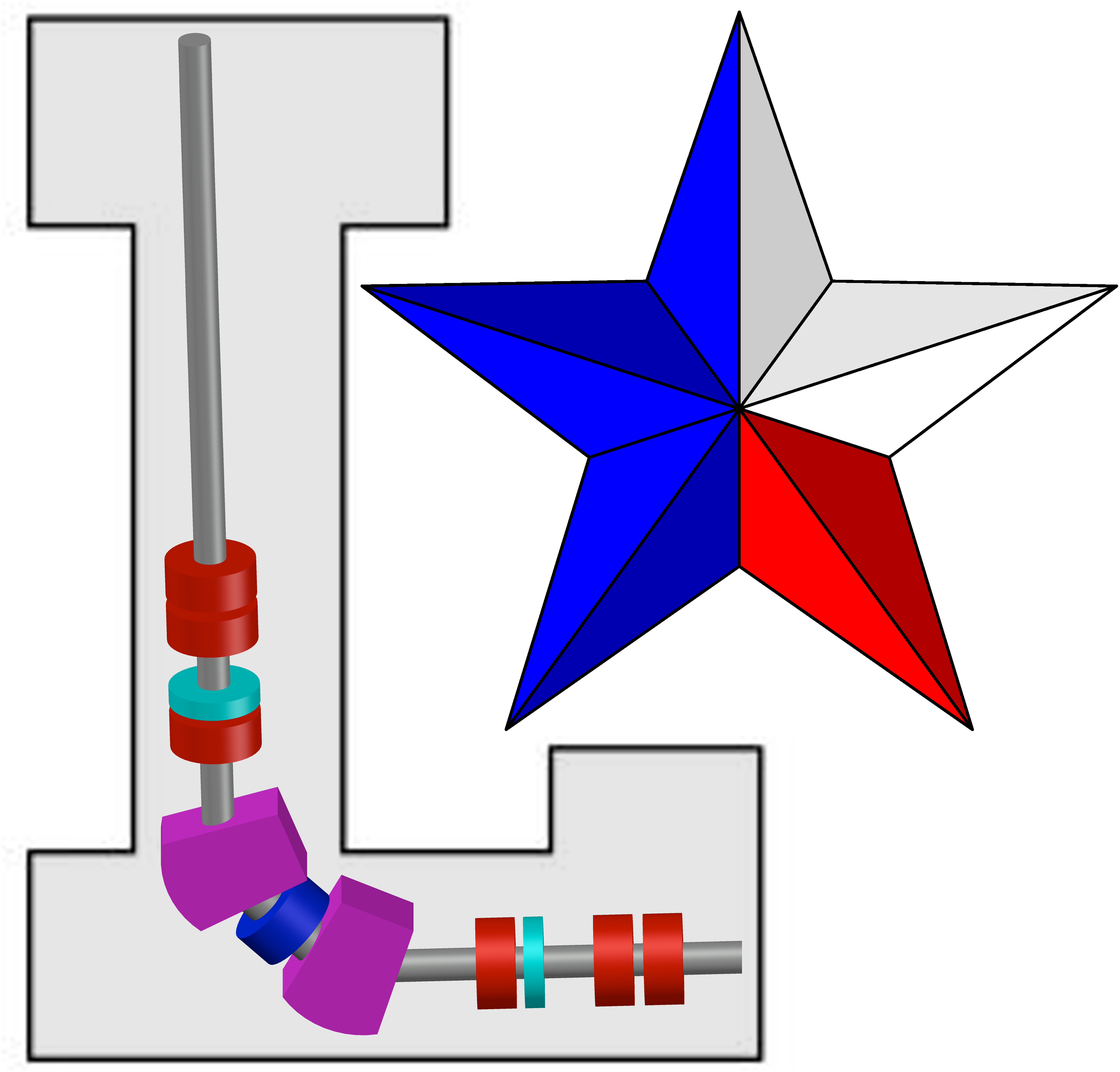Is nature really left handed? Using chilled atoms to find out
Elegant atomic techniques of trapping and polarizing atoms open new vistas for β-decay test of fundamental symmetries.
The Science
The study of how atoms radioactively decay has played a critical role in developing the "standard model" (SM), our modern understanding of the fundamental forces and particles governing our universe. In particular, β decay – a type of radioactive decay caused by the weak nuclear interaction, one of the forces of the SM – has led to a number of revolutionary ideas. Perhaps the most important was the observation in 1957 of an asymmetry of electrons emitted with respect to the initial nuclear spin of 60Co: it demonstrated the startling fact that nature is not ambidextrous, but rather appears to be "left-handed." Handedness refers to the orientation of the spin of a particle; if you curl the fingers of your left hand to follow the spin and your thumb points along the direction of motion, the particle is left-handed. No right-handed particles (in the limit of zero mass) have ever been observed, but there is no compelling reason why they should not exist. In fact, many proposed extensions to the SM propose right-handed particles do exist and are just difficult to detect. The improved precision of asymmetry measurements using modern techniques can improve searches for right-handed particles as well as test other fundamental aspects of the SM.
The Impact
The correlation parameters in β decay depend on the fundamental symmetries underlying the weak interaction. Using lasers and magnetic fields, we are now able to suspend clouds of atoms to a small volume in space and polarize them with very high efficiency. These techniques provide an ideal source of short-lived atoms, allowing the β asymmetry to be measured to great precision. By comparing the observed values to their standard model prediction, such measurements are sensitive to a wide variety of "new physics" predicted by potential successors to the SM.
Summary
Using the TRIUMF Neutral Atom Trap (TRINAT) facility, a collaboration from Texas A&M University, TRIUMF, Tel Aviv University and the University of Manitoba combine magneto-optical trapping and optical pumping techniques to produce an ideal source of short-lived 37K. The magneto-optical trap is extremely selective, only confining the isotopes of interest with zero contaminants. It provides a very confined and cold cloud of highly-polarized atoms which decay from a very shallow trap within an exceptionally open geometry. This allows us to measure the momenta of both the recoil and emitted β daughters in a nearly background-free environment with minimal β scattering effects. Two β telescopes, placed along the polarization axis, observe the number of βs emitted parallel and anti-parallel to the nuclear polarization. The direction of the polarization is easily reversed by simply changing the sign of the circularly-polarized optical-pumping light. This is an ideal situation for determining the correlation of the β with the initial nuclear spin, i.e. the β asymmetry parameter, Aβ.
The asymmetry observed in the β detectors determines the β asymmetry parameter for 37K to within 0.3% of its value. This is the best relative accuracy of any β-asymmetry measurement in a nucleus or the neutron, and is in agreement with the standard model prediction. This experiment has increased sensitivity to new physics compared to other nuclear searches, and improves the determination of Vud for this nucleus alone by a factor of 4. We have identified ways to improve the precision to better than a part-per-thousand, at which point the result will be complementary to searches for new physics at large-scale facilities such as the Large Hadron Collider. In addition to improving the Aβ measurement, TRINAT will use their system to measure other polarized and unpolarized correlation parameters.

The measurement chamber of the TRIUMF Neutral Atom Trap (TRINAT) experiment where the decays of 37K atoms are observed. β telescopes placed above and below the trap center, along the polarization axis, measure the momenta of the βs in the direction of, and opposite to, the nuclear polarization, allowing the precise measurement of the asymmetry to ±0.3%. Not shown are two micro-channel plate detectors and an electrostatic hoop system to collect and observe the daughter recoiling ions and shake-off electrons.
Contact
Dan Melconian
Cyclotron Institute, Texas A&M University
dmelconian@tamu.edu
John Behr
TRIUMF
behr@triumf.ca
Funding
This work was supported by the U.S. Department of Energy, Office of Science, Office of Nuclear Physics (NP), the Natural Sciences and Engineering Research Council of Canada, and the Israel Science Foundation.
Publications
B. Fenker, A. Gorelov, D. Melconian, J.A. Behr, M. Anholm, D. Ashery, R.S. Behling, I. Cohen, I. Craiciu, G. Gwinner, J. McNeil, M. Mehlman, K. Olchanski, P.D. Shidling, S. Smale, and C.L. Warner, "Precision measurement of the β asymmetry in spin-polarized 37K decay." Physical Review Letters 120, 062502 (2018). [DOI: 10.1103/PhysRevLett.120.062502]
B. Fenker, J. A. Behr, D. Melconian, R. M. A. Anderson, M. Anholm, D. Ashery, R. S. Behling, I. Cohen, I. Craiciu, J. M. Donohue, C. Farfan, D. Friesen, A. Gorelov, J. McNeil, M. Mehlman, H. Norton, K. Olchanski, S. Smale, O. Thériault, A. N. Vantyghem and C. L. Warner, "Precision measurement of the nuclear polarization in laser-cooled, optically pumped 37K." New Journal of Physics 18, 073028 (2016). [DOI: 10.1088/1367-2630/18/7/073028]








